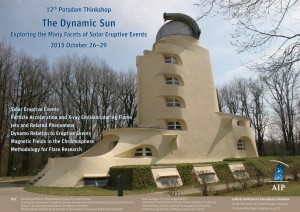Multiwavelength Observations of a Small Emerging Flux Region Observed with GREGOR and SST
Sergio Javier Gonzalez Manrique (Leibniz-Institut für Astrophysik Potsdam (AIP))
Abstract. A small emerging flux region (EFR) containing two pores was observed simultaneously with the Grating Infrared Spectrograph (GRIS) and the GREGOR Fabry-Pérot Interferometer (GFPI) attached to the 1.5-meter GREGOR telescope (Observatorio del Teide, Tenerife) and the CRisp Imaging SpectroPolarimeter (CRISP) attached to the Swedish Solar Telescope (SST, Roque de Los Muchachos, La Palma). GRIS recorded short spectroscopic scans in the spectral range around 1.08 μm. This spectral window included, among other lines, the photospheric Si I 1082.7 nm line, the deep-forming Ca I 1083.9 nm line, and the chromospheric He I 1083.0 nm triplet. The GFPI was used in the spectropolarimetic mode to acquire filtergram images across the photospheric Fe I 630.2 nm line. The time-series allow us to study the dynamics of the observed region at several heights in the solar atmosphere. This study is focused on dynamical aspects at footpoints of chromospheric filamentary structures. In these footpoints, very high velocities are detected. We asses their depth in the photosphere. The various spectropolarimetric scans with CRISP along the Fe I 617.3 nm line will allow us to further infer the magnetic field vector in the photosphere. Space data from the Solar Dynamics Observatory complements this ground-based study.
Contributed Talk

Write a comment Close comment form